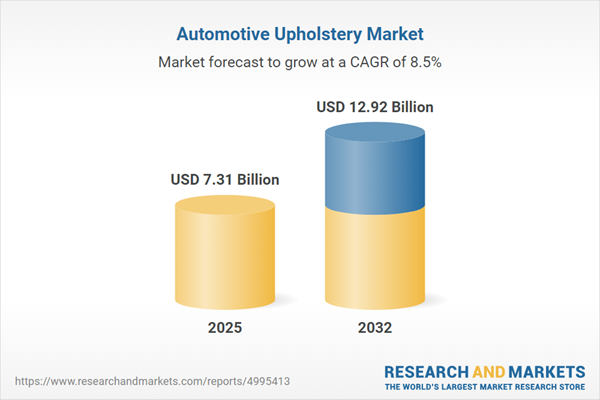Speak directly to the analyst to clarify any post sales queries you may have.
The automotive upholstery market is experiencing accelerated change as regulatory priorities, sustainability objectives, and an enhanced focus on end-user comfort shape evolving business strategies. Material innovation and adapted supply chains are now central to maintaining competitive advantage.
Market Snapshot: Automotive Upholstery Market—Growth, Trends, and Outlook
The automotive upholstery market is registering steady expansion, primarily driven by original equipment manufacturers and suppliers determined to raise the bar for in-vehicle interiors in both retail and fleet vehicle categories. Ongoing advancements in material science and coating technologies are strengthening the quality and aesthetic value of upholstery products, which in turn is accelerating industry momentum. At the same time, operational strategies are adapting rapidly to accommodate heightened consumer expectations and regulatory compliance on a global scale. Stakeholders are leveraging data-driven methods to balance risk and opportunity, supporting compliance and market expansion. The industry continues to see increased investment in customization and production agility, ensuring alignment with ever-changing market and policy landscapes.
Scope & Segmentation: Automotive Upholstery Market Dynamics
- Material Types: Includes Alcantara, full grain leather, advanced fabrics, polyurethane (PU), and polyvinyl chloride (PVC). These contribute to strategic decisions affecting performance, aesthetics, and sustainable lifecycle management, meeting key industry expectations.
- Applications: Upholstery products designed for seats, carpets, door inserts, dashboards, and headliners. These solutions serve both OEM and aftermarket needs and help in meeting distinct regulatory and consumer requirements.
- Vehicle Types: Solutions are tailored for sedans, hatchbacks, SUVs, and commercial vehicles. This diversity enables manufacturers to maintain flexibility and regulatory compliance within specific global and regional contexts.
- Sales Channels: Both OEM and aftermarket channels are leveraged to expand brand presence, support a wide client base, and bolster operational agility in line with market demands.
- Seat Technologies: Heating, cooling, massage features, and memory foam integration are implemented to advance user comfort and differentiated ergonomic value, reflecting an ongoing trend towards user-centric innovation.
- Regional Coverage: The analysis covers the Americas, EMEA, and Asia-Pacific, each with unique infrastructure, consumer patterns, and regulatory frameworks, requiring region-specific approaches for market success.
- Key Companies: Market leadership is shaped by Lear Corporation, Adient plc, Faurecia SE, and Magna International Inc., which continuously influence innovation benchmarks and inform compliance pathways across the sector.
Key Takeaways: Strategic Insights for Decision-Makers
- Modern upholstery materials reinforce both brand identity and customer experience, strengthening appeal for retail markets and fleet operators by enhancing in-vehicle comfort and style.
- Sustainable procurement is increasingly prioritized, with businesses proactively adopting recycled and eco-friendly options to align supply practices and meet evolving compliance standards.
- Automation and 3D knitting streamline production timelines and provide agility, allowing for customization across various vehicle and consumer segments as the industry advances.
- Collaboration among OEMs, suppliers, and technology providers is deepening, enabling modular and adaptive interior solutions that keep pace with global regulatory and consumer preferences.
- Mature markets show a clear preference for enhanced comfort and convenience, while cost and durability remain primary concerns in developing regions; successful business models balance these contrasting needs for sustained performance.
Tariff Impact: Navigating Trade and Cost Pressures
Recent U.S. tariffs on essential raw materials have prompted suppliers in automotive upholstery to boost local sourcing commitments and refine logistics strategies. Such measures are designed to limit the operational risks associated with shifting duties and regulatory changes, allowing for continuity amid global trade uncertainty.
Methodology & Data Sources
This report is underpinned by executive interviews, detailed reviews of regulatory documents, analysis of international trade developments, and ongoing monitoring of patent activity. Scenario forecasting is used for risk evaluation and supports data-driven strategic planning for senior market stakeholders.
Why This Report Matters
- Delivers actionable analysis that helps senior executives link compliance and innovation with broader automotive upholstery market forces.
- Clarifies operational challenges and identifies new avenues for regional growth and procurement strategies in an evolving regulatory context.
- Equips decision-makers with tools to enhance resilience and agility, helping organizations respond effectively to market and compliance pressures.
Conclusion
Continuous transformation within the automotive upholstery market requires persistent innovation, strong sustainability standards, and adaptable supply chain management. Adaptive organizations will maintain competitive momentum as industry shifts continue.
Additional Product Information:
- Purchase of this report includes 1 year online access with quarterly updates.
- This report can be updated on request. Please contact our Customer Experience team using the Ask a Question widget on our website.
Table of Contents
3. Executive Summary
4. Market Overview
7. Cumulative Impact of Artificial Intelligence 2025
Companies Mentioned
The companies profiled in this Automotive Upholstery market report include:- Lear Corporation
- Adient plc
- Faurecia SE
- Magna International Inc.
- Yanfeng Automotive Interiors Co., Ltd.
- Toyota Boshoku Corporation
- Grupo Antolin-Irausa, S.A.
- Aisin Seiki Co., Ltd.
- Tachi-S Co., Ltd.
- Henniges Automotive Holding LLC
Table Information
| Report Attribute | Details |
|---|---|
| No. of Pages | 188 |
| Published | October 2025 |
| Forecast Period | 2025 - 2032 |
| Estimated Market Value ( USD | $ 7.31 Billion |
| Forecasted Market Value ( USD | $ 12.92 Billion |
| Compound Annual Growth Rate | 8.4% |
| Regions Covered | Global |
| No. of Companies Mentioned | 11 |









